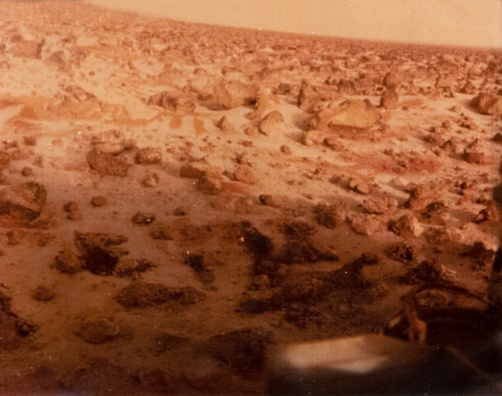Adding item...
Collection Artwork

Title
Viking 2 View of Mars Ice
Creation date
1979
Materials
color photograph
Organization
NASA (Washington DC, established 1958)
Dimensions
image size: 7 1/2 x 9 1/2 in.
paper size: 8 x 10 5/8 in.
frame size: 13 3/4 x 15 1/2 in.
paper size: 8 x 10 5/8 in.
frame size: 13 3/4 x 15 1/2 in.
Credit Line
The Jack Shear Collection of Photography at the Tang Teaching Museum
Place of Creation
photographed at Utopia Planitia, Mars
Accession Number
2020.1.6
Object Type
Marks
Stamped in red ink, left margin, sideways: 79-40-19C[?]
Typed, verso: [NASA logo] NATIONAL AERONAUTICS AND SPACE ADMINISTRATION / HOUSTON, TEXAS 77058 / No copyright is asserted for this photograph. If a recognizable person appears in the photo, use for commercial purposes may / infringe a right of privacy or publicity. It may not be used to state or imply the endorsement by NASA or by any NASA employee / of a commercial product, process or service, or used in any other manner that might mislead. / Accordingly, it is requested that if / this photograph is used in advertising and other commercial promotion, layout and copy be submitted to NASA prior to release. / COLOR / 18 MAY 1979 [large white space] S79-40190 / JET PROPULSION LABORATORY, PASADENA CALIFORNIA / VIKING 2 VIEW OF MARS ICE — This high-resolution color photo of the surface of / Mars was taken by Viking Lander 2 at its Utopia Planitia landing site on May 18, 1979, / and relayed to Earth by Orbiter 1 on June 7, 1979. It shows a thin coating of water ice / on the rocks and soil. The time the frost appeared corresponds almost exactly with the / buildup of front one Martian year (23 Earth months) ago. Then it remained on the / surface for about 100 days. Scientists believe dust particles in the atmosphere pick up / bits of solid water. That combination is not heavy enough to settle to the ground. But / carbon dioxide, which makes up 95 percent of the Martian atmosphere, freezes and / adheres to the particles and they become heavy enough to sink. Warmed by the Sun, / the surface evaporates the carbon dioxide and returns it to the atmosphere, leaving / behind the water and dust. The ice seen in this picture, like that which formed one Martian year ago is extremely thin, perhaps no more than one-thousandth of an inch thick. / PHOTO CREDIT: NASA or National Aeronautics and Space Administration
Typed, verso: [NASA logo] NATIONAL AERONAUTICS AND SPACE ADMINISTRATION / HOUSTON, TEXAS 77058 / No copyright is asserted for this photograph. If a recognizable person appears in the photo, use for commercial purposes may / infringe a right of privacy or publicity. It may not be used to state or imply the endorsement by NASA or by any NASA employee / of a commercial product, process or service, or used in any other manner that might mislead. / Accordingly, it is requested that if / this photograph is used in advertising and other commercial promotion, layout and copy be submitted to NASA prior to release. / COLOR / 18 MAY 1979 [large white space] S79-40190 / JET PROPULSION LABORATORY, PASADENA CALIFORNIA / VIKING 2 VIEW OF MARS ICE — This high-resolution color photo of the surface of / Mars was taken by Viking Lander 2 at its Utopia Planitia landing site on May 18, 1979, / and relayed to Earth by Orbiter 1 on June 7, 1979. It shows a thin coating of water ice / on the rocks and soil. The time the frost appeared corresponds almost exactly with the / buildup of front one Martian year (23 Earth months) ago. Then it remained on the / surface for about 100 days. Scientists believe dust particles in the atmosphere pick up / bits of solid water. That combination is not heavy enough to settle to the ground. But / carbon dioxide, which makes up 95 percent of the Martian atmosphere, freezes and / adheres to the particles and they become heavy enough to sink. Warmed by the Sun, / the surface evaporates the carbon dioxide and returns it to the atmosphere, leaving / behind the water and dust. The ice seen in this picture, like that which formed one Martian year ago is extremely thin, perhaps no more than one-thousandth of an inch thick. / PHOTO CREDIT: NASA or National Aeronautics and Space Administration
Ongoing Research
Research on our collection is ongoing. If you have resources you’d like to share, please contact Associate Curator Rebecca McNamara.